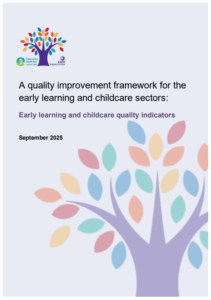Staff skills, knowledge, values and deployment p13
How do we consider staff wellbeing to ensure we provide safe and high-quality care and the best outcomes for children?
Leadership of continuous improvement p15 – Pedagogical leadership
There is a strong focus on improving wellbeing and educational outcomes for children. Staff demonstrate a determination to recognise, respect and promote children’s rights. This reduces inequity, challenges discrimination and improves outcomes for all
Children experience high quality spaces p20 – Quality, safety and maintenance of spaces
We recognise the importance of daily outdoor play and the benefits of this for enhancing learning and wellbeing. We support, facilitate and encourage children to explore and build independence. Children are supported to actively explore and learn about the wider world.
p25
How do we know our setting provides a wide range of challenging outdoor play and learning experiences that promote children’s health and wellbeing?
Playing, learning & Developing p29 – Quality of Interactions
Our highly responsive approach ensures children are developing a broad range of knowledge, understanding and skills for life and learning
Teaching, learning & Assessment p39 -Children’s Learning & Engagement
Children’s wellbeing and developmental needs are met very well through carefully considered transitions, experiences, and learning environments.
We carefully consider the flow of the day, taking into account opportunities for children to maximise learning, be active and offer time and space to rest.
Children are supported to achieve p44 – Nurturing Care & Support (descriptor)
Fostering strong connections with children’s families can have a significantly positive impact on a child’s wellbeing… There is a focus on personal planning that reflects the holistic needs of each child, promotes their wellbeing and supports positive outcomes. The indicator highlights the need to involve children and their families in making decisions about their care and support
Nurturing Care & Support p44 – Nurturing Care
Children experience warm, consistent and responsive care that fosters their wellbeing. They are safe, sensitively cared for and skilfully helped to express their needs
Nurturing Care & Support p45 – Nurturing Care
Children’s food choices are nutritious, culturally appropriate and safely prepared to account for any specific dietary needs, allergies or intolerances. They are aligned with current dietary guidelines including Setting the table and Food Matters.
Nurturing Care & Support p47 – Personal Planning
Children’s wellbeing is supported through effective personal planning…We work proactively with children, families and other professionals to identify support needs and have clear strategies in place to ensure that children’s wellbeing is sustained.
Our approach to personal planning considers best practice guidelines and is grounded in the Getting it Right for Every Child (GIRFEC) framework, utilising wellbeing indicators to assess and plan for children’s overall wellbeing
p51
What do we do to promote sociable and healthy eating experiences?
Wellbeing, Equality & Inclusion p53 – Positive Relationships & Wellbeing
We understand fully that relationships lie at the heart of children’s development and lay the foundation for lifelong learning and wellbeing. The wellbeing of children and families is paramount and is central to the work of our setting.
We actively support our children to be safe, healthy, achieving, nurtured, active, respected, responsible and included. We can demonstrate the significant impact this has on our children’s social, emotional, and mental wellbeing as well as their development and learning.
p57
To what extent do our approaches to inclusion and equality positively impact on children’s wellbeing?
In what ways do we support children at key points of transition to ensure continuity in wellbeing and inclusion?
Children’s Progress p59 – Children’s progress over time
A strong focus on health and wellbeing enhances children’s learning.
Safeguarding & Child Protection p67 – Empowering parents & staff
Our thoughtful approaches support families well to learn about safeguarding and children’s rights within our setting

